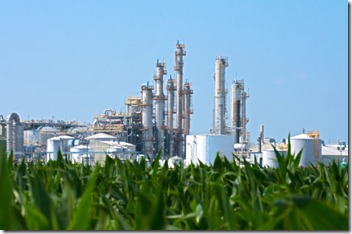Guest Post by Dr. Robert Humphreys
 Most of us are familiar with the popular vision of the petroleum refinery fed by crude oil being replaced by the bio-refinery fed by biomass to provide a perpetually renewable source of fuel, chemicals and plastics. On the other hand, a reader who knows that crude oil and natural gas can be pumped through pipelines to a refinery might wonder how trees, corn stalks, switch grass and yard clippings will be fed to a bio-refinery. This is clearly an important question since a bio-refinery on the scale required for fuel, commodity chemicals and plastics will need an immense, reliable supply of biomass in the appropriate form. For this reason, we will devote some space to methods of processing biomass so it can be fed to a bio-refinery.
Most of us are familiar with the popular vision of the petroleum refinery fed by crude oil being replaced by the bio-refinery fed by biomass to provide a perpetually renewable source of fuel, chemicals and plastics. On the other hand, a reader who knows that crude oil and natural gas can be pumped through pipelines to a refinery might wonder how trees, corn stalks, switch grass and yard clippings will be fed to a bio-refinery. This is clearly an important question since a bio-refinery on the scale required for fuel, commodity chemicals and plastics will need an immense, reliable supply of biomass in the appropriate form. For this reason, we will devote some space to methods of processing biomass so it can be fed to a bio-refinery.
The Steps From Biomass to Bio-Plastic Bottles
We will divide the conversion of biomass to renewable plastic bottles into three major steps:
1. Biomass pretreatment to convert biomass into a form that can be used in a bio-refinery
2. Pretreated biomass conversion to basic chemicals using fermentation, pyrolysis, or chemical treatment
3. Conversion of basic chemicals to monomers and polymers for renewable plastic bottles
We will discuss each step in a separate post.
Step 1. Biomass Pretreatment
If you think about it for a minute, it will be clear that chunks of wood and blades of grass are very cumbersome forms of biomass to move around any manufacturing facility. Just conveying tons of biomass around a bio-refinery will require that it be converted to a more manageable form. This can be accomplished by chopping the raw biomass into very fine particles, typically a millimeter or even smaller. Particles of this size are easily conveyed and provide much more surface area than chunks of wood or blades of grass. High surface area means rapid heating or lots of contact with process chemicals, both of which help speed further processing. Faster processing generally means better economics.
Additional pretreatment beyond chopping is usually necessary. For some bio-refinery processes under development, the chopped, raw biomass needs to be dried thoroughly since biomass water content can range from 20-60% depending on the source. Other bio-refinery processes require the chopped biomass to be treated with hot water or steam to open up the fiber structure to make the biomass molecules more accessible to further treatment by enzymes or acids.
In most cases, the biomass undergoes still more pretreatment to convert it to smaller molecules. This conversion is analogous to the step in petroleum refining where the large molecules in the oil are “cracked” into smaller molecules. Biomass can be “cracked” in several ways:
Cracking into Bio-Oil
Finely chopped biomass is fed into a furnace in the absence of oxygen and heated very rapidly to a high temperature (as high as 6000C /11000F) for a very short time (a few seconds). The technical term for this heating process is “fast pyrolysis”. The large cellulose, hemicellulose, and lignin molecules are broken down into a thick, dark brown liquid called “bio-oil” or “pyrolysis oil”. Bio-oil contains a complex mixture of hundreds of small molecules and can be separated into water-soluble and water-insoluble fractions. Bio-oil is corrosive and is a poor fuel but can be upgraded to valuable fuel and chemicals using catalyst technology similar to that for upgrading small molecules from petroleum cracking. A photo of bio-oil being poured shows that it is aptly named.
Cracking into Sugars
At least three distinct processes for “cracking” biomass to sugars are being developed by different companies. The cellulose and hemicellulose are broken down into glucose- and xylose- rich sugar solutions in water. In all of the processes, lignin is not broken down and is usually separated and used as fuel for heat needed in the process. The three processing methods use enzymes or strong acids or supercritical water (water at very high temperature and pressure) to hydrolyze (i.e. break down) the cellulose and hemicellulose. The enzymes typically are proprietary, engineered versions of enzymes that are involved in cellulose digestion in the guts of termites and ruminants such as cows. The strong acids need to be recovered and recycled to avoid or minimize waste generation. The supercritical water process is carried out in several steps to avoid decomposition of the more easily broken down hemicellulose. Since conversion of sugars to chemicals usually requires concentrated sugars, all three processes probably will need a water-removal step.
Chopped, dried biomass, bio-oil, and sugar solutions are the three main forms of feedstock that are being studied for upgrading to fuel and chemicals. While biomass conversion may already seem complex, we remind the reader that each step in conversion of biomass can be related to a similar step in the well established conversion of petroleum to fuel and chemicals that is the source of so much of the energy and materials that we use every day.
In the next post, we will examine the different upgrading processes that are currently under development with emphasis on production of chemicals that can be converted into monomers for renewable plastic bottles.

Leave a Reply